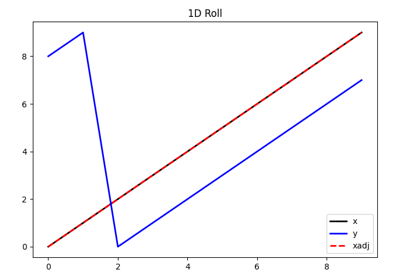pylops.Roll#
- class pylops.Roll(dims, axis=-1, shift=1, dtype='float64', name='R')[source]#
Roll along an axis.
Roll a multi-dimensional array along
axisfor a chosen number of samples (shift).- Parameters
- dims
listorint Number of samples for each dimension
- axis
int, optional New in version 2.0.0.
Axis along which model is rolled.
- shift
int, optional Number of samples by which elements are shifted
- dtype
str, optional Type of elements in input array.
- name
str, optional New in version 2.0.0.
Name of operator (to be used by
pylops.utils.describe.describe)
- dims
Notes
The Roll operator is a thin wrapper around
numpy.rolland shifts elements in a multi-dimensional array along a specified direction for a chosen number of samples.- Attributes
- shape
tuple Operator shape
- explicit
bool Operator contains a matrix that can be solved explicitly (
True) or not (False)
- shape
Methods
__init__(dims[, axis, shift, dtype, name])adjoint()apply_columns(cols)Apply subset of columns of operator
cond([uselobpcg])Condition number of linear operator.
conj()Complex conjugate operator
div(y[, niter, densesolver])Solve the linear problem \(\mathbf{y}=\mathbf{A}\mathbf{x}\).
dot(x)Matrix-matrix or matrix-vector multiplication.
eigs([neigs, symmetric, niter, uselobpcg])Most significant eigenvalues of linear operator.
matmat(X)Matrix-matrix multiplication.
matvec(x)Matrix-vector multiplication.
reset_count()Reset counters
rmatmat(X)Matrix-matrix multiplication.
rmatvec(x)Adjoint matrix-vector multiplication.
todense([backend])Return dense matrix.
toimag([forw, adj])Imag operator
toreal([forw, adj])Real operator
tosparse()Return sparse matrix.
trace([neval, method, backend])Trace of linear operator.
transpose()
